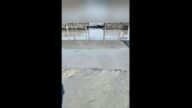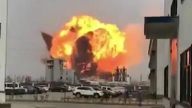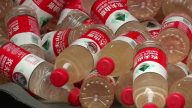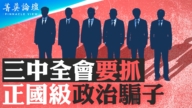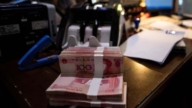【新唐人2013年06月15日讯】最近几年,随着中国城镇化的扩大,一些原来的垃圾场,回收场以及化工企业用地,悄然变成了住宅区和商业区,然而这些被污染过的土地,其中的毒素释放,会持续几十年甚至上百年。因此居住在这些有毒土地上的民众,受到的健康威胁令人怵目惊心。
英国《卫报》报导,中国两位公民高胜科和王凯,近年来致力于调查和揭露中国城市受污染土地,一系列的报告,获得了“中国对话”的最佳调查奖,和2013年《卫报》的中国环境报导奖。中国在受污染的土地上建筑住宅楼问题,再一次引起媒体的关注。
报导说,有的农药厂刚搬走,土壤还来不及修复,就被开发成楼房卖掉。
“台湾师范大学”化学系教授、环境毒理学专家吴家诚指出,污染过的土壤中存在着可挥发和不可挥发的两种毒素,都会威胁到人体健康。
台湾师范大学化学系教授 吴家诚:“土壤或地下水有一些有机溶剂,像汽油这一类的东西污染的时候,它慢慢会挥发,有时会引发淋巴癌症,或血癌,以及呼吸器官的癌症都会产生。”
吴家诚指出,在很多残留于土里的工业材料中,存在不能挥发的重金属,也会通过接触方式对人体造成伤害,特别是小孩容易受影响。
吴家诚:“那另外一部分是不会挥发的,所谓建筑业的建筑废液,电池回收工厂的一些材料等等之类,它里面就有一些重金属,它遍存我们居住环境的周围,小孩出去玩耍的时候,可能身上或皮肤上就会粘到这些重金属,还有可能带入到体内,那这个时候对健康也会有影响。”
吴家诚说,对这种含有重金属的区域,应该要有相关的法律配套措施。在台湾,通常会把土地整治干净后,才做后续利用。
上世纪70年代末,美国发现在原化学废料填埋场上建起的住宅区,出现流产、死胎、肿瘤等现象后,制定了“棕地法案”。
吴家诚还指出,有些不易挥发的污染物,毒性释放会长达几十年,甚至上百年,易挥发的也要持续几十年。
重庆从2004年到2012年,搬迁了137家污染工厂,这些厂区现在大多变成了主要的房地产区。江苏则连续三年,搬迁了4,000多家污染严重的化工企业,留下多少大面积污染土地﹖还是未知数。
而在北京,2001年和2005年间,搬迁了142家工厂,空出了878万平方米可重复用地。据中共北京环保局官员说,从2004年到现在,只有几十个污染场址被确定。
另外,中国社会活动家胡佳反映,很多垃圾填埋厂,非金属处理厂倒闭后,都开发成了住宅区或商业区。
中国社会活动家 胡佳:“因为土地是最有价值的,现在当局搞土地财政,聚敛财富,不管土地原来的用途是什么,你是核废料的填埋场也罢,你是垃圾场也罢,你是冶炼的矿产这些东西也罢,它反正给你开发出来,只要能卖钱,出手以后就跟它无关了,这种东西在中国各地都是挺普遍的。”
胡佳表示,因为民众不知情或缺乏这方面的知识,认为既然政府通过了,应该不会有问题。胡佳说,这些楼房一出来,同样出手很快。
在中国,农药厂通常把农药残留和有害化学残留物,现场掩埋到地面以下五、六米深处。2004年4月,北京南三环地铁施工现场,三名工人在地下作业时中毒。那里原来是一个农药厂。
2006年7月,苏州南二环路附近,一家化工厂搬走后,留下20亩受污染的土地,现场的6名建筑工人在挖土时昏迷。
2007年中国新年期间,在武汉鹤山一个施工现场,当开挖到深层的土壤时,工人们一个接一个出现头晕,呼吸困难。最后,数名中毒工人被送往医院接受紧急治疗,那里是一个农药厂的旧址。
采访编辑/刘惠 后制/李若琳
Building Development on Toxic Land in China
With expansion of urbanization in China in recent
years, land originally used as garbage dumps,
recycling yards and chemical enterprises has quietly
been turned into residential and commercial areas.
This land is contaminated, where toxins continue
to be released for decades or even centuries.
For people living on this toxic lands,
the threat to their health is shocking.
According to The Guardian, two Chinese citizens,
Wang Kai and Gao Shengke had been working to
investigate and expose contaminated urban land.
They have generated a series of reports.
They won China Dialogue best investigation award, and
Guardian’s 2013 China Environmental Reporting Award.
Residential buildings on contaminated land
has once again attracted media attention.
It was reported that after some pesticide factories
relocated, and before the soil was decontaminated,
it was developed into a residential building for sale.
Wu Jiacheng, professor of chemistry are Taiwan Normal
University, and environmental toxicology expert, commented.
Contaminated soil has volatile and non-volatile
toxins, and all are a threat to human health.
Professor Wu Jiacheng: “Soil or groundwater has some
organic solvents, such as gasoline contamination or similar.
This will slowly evaporate, and sometimes cause lymphatic
cancer, or leukemia, and cancer of the respiratory organs.”
Wu Jiacheng said that non-volatile heavy metals
remain in the soil within many industrial materials.
They will cause harm to humans
on contact, especially children.
Wu Jiacheng: “The non-volatile parts, such as the so-called
construction waste, or some battery recycling plant materials,
have heavy metals inside, spreading into the environment.
When children play outside, these heavy
metals may stick to their skin or body.
They may even enter inside their bodies,
which can also affect their health.”
Wu Jiacheng said that for areas containing heavy metals,
it should have a system of laws and supporting measures.
In Taiwan, they will usually conduct land
remediation before subsequent usage.
In the late 1970s, incidents occurred in the United States.
In residential areas where land was originally
used as chemical waste landfill, miscarriages,
stillbirths, cancer and other phenomena appeared.
This led to the creation of the Brownfield Bill.
Wu Jiacheng also notes that with some
non-volatile contaminants, toxic release
will last for decades, or even centuries.
Even volatile ones will last for decades.
From 2004 to 2012, 137 polluting
factories had relocated in Chongqing.
Most of these plant areas have now
become major real estate areas.
In three consecutive years, more than 4,000 polluting
chemical companies relocated in Jiangsu Province.
How many large areas of contaminated
land still remain? It is still unknown.
In Beijing, from 2001 and 2005, 142 factories relocated,
leaving 8.78 million square meters of land for a new use.
According to the Beijing Environmental Protection
Bureau, from 2004 to the present, only a few
dozen contaminated sites were identified.
Chinese social activist Hu Jia commented.
After closure of many landfills and non-metallic
treatment plants, the areas were all developed
into residential or commercial areas.
Hu Jia: “Because land is the most valuable,
authorities engage in land finance to collect wealth.
This is regardless of the original land usage.
No matter whether it was nuclear waste
landfill, a garbage dump or mineral plant,
they will be developed into real estate
areas, as long as it could make money.
Once sold, it has nothing to do with them any
more. This is quite common everywhere in China.
Hu Jia said that because people did not know it,
or lacked related knowledge, they thought that
if the government allowed it, it wasn’t a problem.
Hu said that once these buildings went
on the market, they were sold quickly.
In China, pesticide plants usually bury pesticide residues
and harmful chemical residues in 5-6 meter deep pits.
In April 2004, at a Beijing subway construction
site of the South Third Ring Road, three workers
were poisoned when working underground.
It was because a pesticide plant was originally there.
In July 2006, near the South Second Ring
Road in Suzhou, a chemical plant relocated.
It left 20 acres of contaminated land, and six
construction workers went into a coma when digging.
During 2007 Chinese New Year period, at a
construction site in Heshan, Wuhan, suffered dizziness,
and began to have difficulty breathing one by one.
This was when they were doing deep soil excavations.
Finally, a number of poisoned workers were
taken to hospital for emergent treatment.
It was also previously a pesticide plant.




